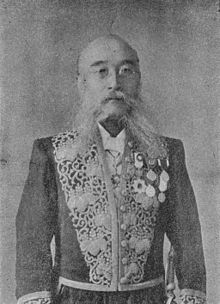Chisaka Takamasa
Chisaka Takamasa | |
|---|---|
 Portrait of Chisaka Takamasa | |
| Personal details | |
| Born | March 11, 1841 Yonezawa Domain, Yamagata, Japan |
| Died | December 3, 1912 (aged 71) |
| Nationality | Japanese |
| Father | Takaaki Chisaka |
| Occupation | Soldier, bureaucrat, businessman |
Chisaka Takamasa (千坂 高雅, March 11, 1841 – December 3, 1912) was a Japanese samurai of the late Edo period who went on to become a soldier, government official, and businessman in the Meiji era. He served as a karō in the Yonezawa Domain's administration.
Biography[]
Takamasa was born in 1841 to a prominent samurai family in the Yonezawa Domain. His father was Takaaki Chisaka, who was the chief retainer of the Yonezawa clan.[1] He entered official service in 1863 and five years later he was given command of the han military force.[2] He was promoted as a dai-sanji (chief councilor) in 1870 and later accompanied the clan lord Shigenori Uesugi on his European tour.[2] When he returned to Japan, he served in the government's Home Ministry.
After his retirement from government service, Takamasa joined the private sector, holding executive positions at companies such as the Ryou Ginko (Ryou Bank), Ujigawa Hydroelectric Power Station, and Yokohama Soko (Yokohama Warehouse).[1]
Takamasa's career articulated the transition of the lives of the samurai from service to their lords to civil or government service in modern Japan. This development was underpinned by the relationships between the samurai and their previous lords. In the case of Takamasa, his former liege promoted his employment – as was done for other former samurai (shizoku jusan) of the Kanazawa – by getting his appointment as Nomi County Chief approved.[3] He was later appointed as the governor of Ishikawa Prefecture.[4]
References[]
- ^ Jump up to: a b "Chisaka, Takamasa | Portraits of Modern Japanese Historical Figures". www.ndl.go.jp. Retrieved June 16, 2020.
- ^ Jump up to: a b Baxter, James C. (1994). The Meiji Unification. Cambridge, MA: Harvard East Asian Monographs. p. 196. ISBN 0674564669.
- ^ Baxter, James C. (1994). The Meiji Unification Through the Lens of Ishikawa Prefecture. Cambridge, MA: Harvard Univ Asia Center. p. 222. ISBN 0674564669.
- ^ Checkland, Olive (2003). Japan and Britain After 1859: Creating Cultural Bridges. London: RoutledgeCurzon. p. 216. ISBN 0700717471.
- Chisaka, Takamasa | Portraits of Modern Japanese Historical Figures at www.ndl.go.jp
- æPRãÄòËåEÝ ãÎö at www8.ocn.ne.jp
- Japanese expatriates in the United Kingdom
- Japanese military personnel
- Samurai
- Karō
- 1841 births
- 1912 deaths
- People of the Boshin War
- Meiji Restoration
- Kazoku
- Members of the House of Peers (Japan)
- Uesugi retainers
- Samurai stubs